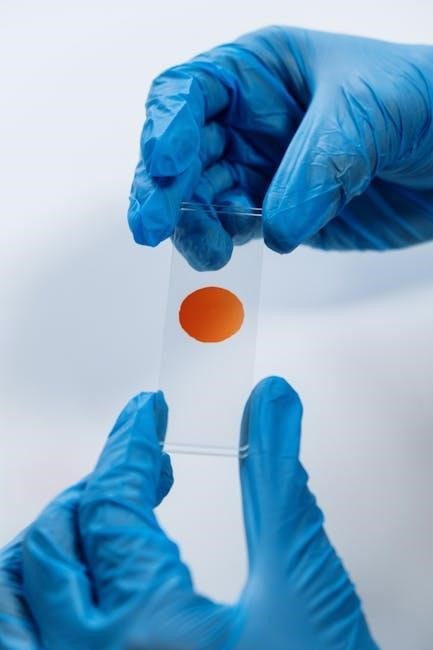Clinical trials are systematically conducted to assess the safety‚ efficacy‚ and effectiveness of new treatments. They progress through structured phases‚ each building on the previous‚ ensuring rigorous testing and regulatory approval.
Overview of Clinical Trials
Clinical trials are meticulously designed experiments aimed at evaluating the safety‚ efficacy‚ and effectiveness of new drugs‚ devices‚ or treatment regimens. Conducted in a structured‚ phased manner‚ these trials ensure that medical interventions are thoroughly tested before being approved for widespread use. Each phase builds on the previous one‚ starting with small-scale studies in Phase 0 and expanding to larger‚ more diverse populations in later stages. The primary goal is to protect participants while gathering critical data to inform healthcare decisions. Trials are regulated by strict ethical and scientific standards‚ ensuring transparency‚ participant safety‚ and reliable outcomes. By systematically assessing risks and benefits‚ clinical trials play a pivotal role in advancing medical knowledge and improving patient care. Their findings guide regulatory approvals and inform evidence-based practices in healthcare.

Phase 0: Exploratory Studies
Phase 0 trials are small-scale‚ exploratory studies assessing how a drug behaves in the human body. They focus on pharmacokinetics and pharmacodynamics‚ using microdoses to gather early data.
Purpose and Design of Phase 0 Trials
Phase 0 trials are exploratory studies designed to assess how a drug behaves in the human body. Their primary purpose is to gather early data on pharmacokinetics (how the body processes the drug) and pharmacodynamics (the drug’s effects on the body). These trials use microdosing‚ involving doses much smaller than those intended for therapeutic use‚ to minimize risks. Typically‚ only 10-15 participants are enrolled‚ and the studies last about one week. The goal is to identify promising candidates early‚ reducing the time and cost of drug development. Phase 0 trials do not evaluate safety or efficacy but rather focus on understanding drug disposition and targeting. This phase helps streamline the development process by providing critical insights before proceeding to larger-scale trials.
Phase I: Safety and Dosage Assessment
Phase I trials evaluate the safety and tolerability of a new drug in a small group of healthy volunteers. The primary focus is on identifying side effects and determining the maximum tolerated dose.
Focus on Safety and Tolerability
In Phase I trials‚ the primary objective is to assess the safety and tolerability of an investigational drug. A small group of healthy volunteers‚ typically between 20 to 100 participants‚ is enrolled to evaluate how the drug behaves in the human body. Researchers closely monitor participants for adverse reactions‚ ensuring the drug does not cause unacceptable side effects. Key aspects include determining the maximum tolerated dose‚ identifying dose-limiting toxicities‚ and studying pharmacokinetics to understand how the drug is absorbed‚ distributed‚ metabolized‚ and excreted. This phase also employs dose escalation studies‚ where incrementally higher doses are administered to identify the optimal balance between efficacy and safety. The findings from Phase I lay the foundation for subsequent phases‚ ensuring that only safe and tolerable treatments advance to further testing.
Phase II: Efficacy and Further Safety Testing
Phase II trials assess the efficacy of treatments and further evaluate safety in a larger‚ more diverse participant group‚ building on Phase I findings to determine effectiveness.
Phase IIa and Phase IIb Trials
Phase IIa trials focus on determining the optimal dosage of a treatment‚ assessing its pharmacokinetics‚ and identifying potential biomarkers. These trials refine dosing regimens to maximize efficacy while minimizing adverse effects. Phase IIb trials‚ on the other hand‚ evaluate the treatment’s effectiveness at the established dose. They involve larger‚ more diverse patient populations to confirm therapeutic benefits and further assess safety. Together‚ these phases provide critical data to inform Phase III trials‚ ensuring that only the most promising treatments advance. By refining both dosage and efficacy‚ Phase IIa and IIb trials play a pivotal role in the clinical trial process.

Phase III: Large-Scale Efficacy Confirmation
Phase III trials involve large-scale studies to confirm the treatment’s efficacy in diverse populations‚ comparing it to standard therapies or placebos. This phase ensures safety and effectiveness.
Comparison with Standard Treatments
Phase III trials often involve comparing the experimental treatment with existing standard therapies. This comparison helps determine if the new treatment is more effective or has fewer side effects. Researchers use randomized controlled trials to minimize bias‚ ensuring reliable results. By evaluating the new treatment against established methods‚ they can assess its potential to improve patient outcomes. This phase also identifies any specific patient populations that may benefit more from the new treatment compared to current options.
Expansion Cohorts in Phase III
Expansion cohorts are additional groups of participants added to Phase III trials to gather more data on specific outcomes or populations. These cohorts allow researchers to further explore the treatment’s effectiveness in diverse patient groups‚ such as those with specific biomarkers or comorbidities. This phase also enables the collection of longer-term safety and efficacy data. Expansion cohorts can provide insights into how the treatment performs in real-world settings‚ helping to identify any subgroup differences in response. Additionally‚ these cohorts may explore the treatment’s effects in special populations‚ such as pediatric or geriatric patients‚ which were not extensively studied in earlier phases. The data from expansion cohorts contribute to the overall assessment of the treatment’s benefits and risks‚ supporting regulatory submissions and informing post-marketing strategies.

Phase IV: Post-Marketing Surveillance
Phase IV involves post-marketing surveillance to monitor a drug’s long-term safety and effectiveness in the general population‚ identifying rare side effects and informing real-world treatment guidelines.
Monitoring Long-Term Safety and Effectiveness
Phase IV trials focus on monitoring the long-term safety and effectiveness of approved treatments in a larger‚ diverse population. These studies aim to identify rare side effects‚ assess long-term outcomes‚ and evaluate the drug’s performance in real-world settings. They also investigate potential drug interactions‚ optimal dosing‚ and the impact of prolonged use. Data collected during this phase helps refine treatment guidelines and ensures the medication remains safe and effective for all patients. Regulatory agencies often require ongoing surveillance to maintain market approval. This phase is crucial for addressing any unforeseen issues that may arise after widespread use‚ ensuring public health and safety remain prioritized.
